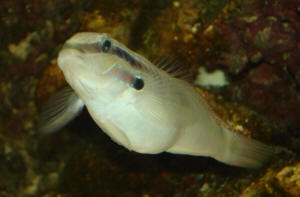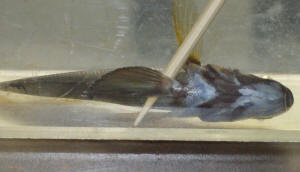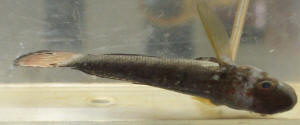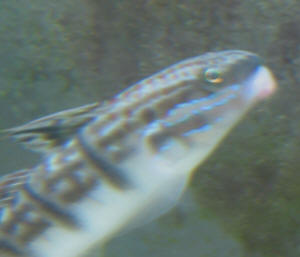|
FAQs on Amblygobius Gobies,
Disease/Health
Related Articles: Genus
Amblygobius Gobies,
Related FAQs: Amblygobius Gobies
1, Amblygobius Gobies 2, & FAQs on:
Amblygobius Identification, Amblygobius Behavior, Amblygobius Compatibility, Amblygobius Selection, Amblygobius Systems, Amblygobius Feeding, Amblygobius Reproduction, & True Gobies,
Gobies 2, Goby Identification, Goby Behavior, Goby Selection, Goby Compatibility, Goby Feeding, Goby Systems, Goby Disease, Goby Reproduction, Clown Gobies, Neon Gobies, Genus Coryphopterus Gobies, Mudskippers, Shrimp Gobies, Sifter Gobies,
|

|
Rainfordi update 7/2/15
Hello,
<Borja>
I forgot to report about my "Amblygobius rainfordi with ex-sunken belly
11/9/12". Unfortunately it died around December 2014.
It looked fine, but it begun to look fatter than usual and slower. After around
a month
of decay it died.
<Ahh; very common source of mortality... slow wasting... need a vigorous
refugium, a good deal of other endogenous source of live foods to do well in
captivity>
I'm not sure about the usual lifespan for them and, of course, I can't know how
old it was when it arrived in Summer 2012.
Borja.
<Cheers, BobF>
Sand-Sifting Goby (Starved Due To Old Age?) --
04/07/10
Hello Eric,
<<Hiya Gene>>
Just a follow up on a different topic.
<<Okay>>
My sand sifting goby died today. I had him for about 2 years.
<<Mmm, died of old age perhaps... Some species only live a couple
years with many going only a couple to a few more than that. And it
seems the smaller the species the shorter the lifespan>>
He did a wonderful job keeping the sand in good condition.
<<Ah yes'¦ I am fond of Amblygobius phalaena for this
purpose as it seems less prone to 'dust' my
corals 'though it is still a prodigious digger that can
disrupt a DSB'¦and gets too large (easily to 5' in
captivity) for all but the largest home systems, in my
opinion>>
He began getting thinner and thinner
<<I have noted this with several fishes I thought to be getting
'long in the tooth'>>
-- I tried target feeding him some Nori -- but it just wasn't
enough. I really don't know if he died of old age or starvation.
How likely do you think is was starvation?
<<If it was not provided supplemental feedings (New Life Spectrum
pellets are great for this), this is always a possibility.
But'¦ I have seen fishes that were/are seemingly well fed
begin to 'waste away' in their old age. I'm not sure if
this is a result of a loss of ability to metabolize foods or the loss
of ability to simply 'compete' for foods 'either
way'¦'old age' does seem to play a part in the fishes
'ability to get enough nutrition' to maintain body
weight>>
I would hate to buy another one only to see it suffer.
<<In my experience, these fish are generally hardy aquarium
inhabitants that will eat almost anything. There could be a myriad of
reasons for a fish to starve to death...anything from inadequate
foods/feedings offered, to bullying, to parasites 'and yes,
maybe even just old age. If you have the proper environment and the
fish is fed/accepts several small feedings daily of quality food items
(I very highly recommend the NLS pellets for ALL your fishes) then I
think there is little chance of another similar fish is going to
'suffer'>>
Thanks,
-gene
<<Happy to share'¦ Eric Russell>>
Re: Sand-Sifting Goby (Starved Due To Old Age?) --
04/07/10
Nice reply!
<<Glad you think so!>>
I will be looking for another based on your comments.
<<Very good>>
And will add NLS pellets to his diet.
<<Ah yes! All your fishes and inverts that will accept/ingest
this excellent prepared food will benefit>>
BTW, my tank is a 125g mixed reef with 30g refugium.
<<Ah good 'though most are not exceedingly large, I do
think these Gobies enjoy a bit of real estate to roam and
'chomp' upon. The refugium is also an excellent adjunct to your
system, for many reasons, not the least of which is to help keep your
substrate populated>>
Regards,
-gene
<<Cheers'¦ EricR>>
R2: Sand-Sifting Goby (Starved Due To Old Age?) --
04/08/10
Can't readily locate the golden head sleeper goby in the Atlanta
area -- so thinking of trying the orange spotted goby. Did some reading
and the V. puellaris seems to be a good alternative to the V. strigata.
What'da think?
-gene
<<Hi Gene'¦ These two Valenciennea species are similar
in size/captive care requirements. V. puellaris may be a 'bit more
delicate,' but if you can find one that will accept the NLS
pellets, I give you good odds. EricR>>
R3: Sand-Sifting Goby (Starved Due To Old Age?) --
04/09/10
Well, the Valenciennea puellaris was much too small for my tank.
<<'¦?>>
I finally purchased a Dragon goby (Amblygobius phalaena)
<<A hardy choice, in my experience/opinion 'and much
less prone to 'crop-dusting' your corals than the Valenciennea
species>>
-- did not seem to be as prolific at sifting
<<It will do the job'¦ These Dragon or, Bullet Gobies as
they are also called, just don't 'travel as they sift' like
the Valenciennea do>>
-- but could do the job.
<<Mine was able to keep up with a 375g display, just
fine>>
Only got one but may add another unless they don't get along
well.
<<Can be problematic re'¦I recommend you stick to just
the one for the size system you have>>
-gene
<<Cheers'¦ EricR>>
|
Amblygobius phalaena Death, mystery
3/23/09
Hello WWM Crew,
<Jesse>
My Banded Sleeper Goby died tonight and I have no idea why. To
start off with, I've had the fish for about six months. It
has been in its current tank for about three months, with
absolutely no problems until now. Its
current tank is a 90 gallon reef tank. Tank members are as
follows: cleaner shrimp, 3 blue-green Chromis, 2 ocellaris
clowns, six line wrasse, coral beauty, Longnose Hawkfish,
Acanthurus japonicus, and assorted corals. The fish all get along
and never fight. This afternoon I fed the fish as I usually do,
and the Goby ate like pig and seemed to be its usual self.
Later that afternoon I cleaned the glass panels and performed a
10% water change. After the water change I observed the tank and
noticed that the Goby was resting on the sand and mouth
breathing. I also noticed that there were a few white patches
around its head. Over the course of the next 2-1/2 hours the
mouth breathing continued until the fish was belly up and dead. I
am completely puzzled on how over the course for 3 hours my Goby
could go from seemingly in perfect health to dead. All other
corals and tankmates appear to be in perfect health and show no
signs of stress or illness. Also, all water parameters are great.
I've attached a few post-mortem pictures that show the white
spots. Also, you can see reddening of the caudle fin. If you have
any thoughts as to the cause of death, please let me know. Thank
you in advance for your response.
-Jesse
<Mmm, not possible to state exactly, but I can/will speculate
as to what might have been a/the cause here... of predatory
possibilities, the Six Line Wrasse... is most likely, perhaps the
Cleaner Shrimp, particularly if it is a Stenopid... This
Amblygobius could have "accidentally" gotten stung by
the corals... it might have injured itself by jumping, being
startled and swimming into something hard... Lastly, it might
have had something internal wrong... that led to its demise in
other ways... This fish does appear to have been
"chewed" about its head (your photos are excellent),
but this could have occurred "after the fact" of its
demise. Bob Fenner>
|
  |
Skinny Rainford, Chances of Recovery
1/29/09 Hi, <Hello there> Thank you for taking time to
answer my query. I'm no stranger to gobies, and I keep a goby
specific QT stocked with liverock, sand, algae and contains numerous
small crustaceans running at all times. Since I researched the diet of
Rainford and its congeners, I added large amounts of various hair algae
species to the QT and made sure that other live food sources had
sufficiently developed before the Rainford's arrival. I observed
the Rainford eating at store, though it did look slightly pinched
ventrally and slim laterally, he did not have an arched posture. Even
though the fish is eating live critters and prepared foods (enriched
brine shrimp, Cyclop-eeze, brine nauplii, and prawn ova), it still
hasn't accumulated significant body mass in about one month.
<Unfortunately all too typical> It has however, become more
colorful and active. <Good signs> Despite those positive signs,
I'm concerned that my Rainford Goby maybe too emaciated to fully
recover. <Also very common> Based on your experience, does this
fish seem as though it has a chance or are my efforts only prolonging
the inevitable? <I am not a fan of giving up... perhaps too stubborn
for my own, others good at times... I would "hang in
there"... keep trying, adding refugium life, more frequent, soaked
(HUFA, vitamin) foods...> Thank you for your time, SI <And you
for sharing. Bob Fenner>
Amblygobius hlth. 12/23/08 Thanks for the prompt
response Bob, <Welcome Nick> I've just ordered myself an
Amblygobius phalaena which will be going into QT for 2 weeks so my
fingers are crossed that these are just bumps and scrapes. <I do
think they are... do keep an eye on the Goby... both to make sure it
isn't getting too skinny... and to assure the top is on so it
doesn't jump out! I am a fan of just dipping, summarily placing
this genus in main displays> Have a merry Christmas! Nick <Happy
holidays to you and yours. BobF>
|
Bump on Bullet Goby's Mouth - Help!
10/8/08 Wet Web Media Crew, <Howdy> My wife and I
would like to offer a sincere thank-you for providing such a
wonderful resource in your website and all of the services you
provide. <Welcome> About 2 months ago we purchased a bullet
goby from a reputable retailer, in an attempt to help moderate
our algae situation. A few weeks after bringing him home, we
noticed a little pink bump under the bottom lip - since he digs
and rearranges the gravel every night we suspected a physical
injury. Over the past 2-3 days, the bump has become significantly
bigger and is now pinkish at the base and whitish at the surface
(see blurry pic). <I see> In our 55g tank (established for
about 15 months), we have a couple of snails, a peppermint
shrimp, a clown fish, and some hermit crabs (and of course live
rock and adequate amount of bottom media). The problem is
difficult to observe because he hides under some live rock
whenever we get too close. His appetite seems normal, breathing
does not appear labored, he swims around a lot and sifts the
gravel as he always has. Can you suggest some causes / treatments
for our friend? <Mmm, yes, can, will... I would not treat this
growth directly with any "medicine" per se, but do what
you can to indirectly boost its chances of healing... by adding
vitamin/HUFA prep. directly to the water and foods (e.g. Selcon,
MicroVit), and keeping the system water quality stable,
optimized. Bob Fenner> Many Thanks, Laura & Josh
|
 |
Parasitic Disease: Tough Treatment Choices Well,
unfortunately, the passer didn't survive through Thursday
night... Not sure if it was Amyloodinium or Brooklynellosis,
but it was pretty fast...less than 2 days from first sign of any
symptoms to death. I suppose I should have done the freshwater dip to
try to verify which parasite it was. Might have made a small
difference... Happened so fast... <Sorry to hear that...Scott F.
following up for Marina today> My concern now is the
Ranford...extreme sensitivity to copper and other meds...Do I just wait
and see, let nature take it's course? (can you see me
cringe?) Or is there another course of action for these
little fishes? I can find so little written on treatment,
that I'm stumped...the disease/parasite might kill them, but the
medication will kill them too. Thanks. <Well, you could use a
medication containing Formalin. The fish may have difficulties with it
as well, but it may be worth the shot if it is very sick. Marina's
treatment advice was right on. Unfortunately, at this point, you may be
compelled to use a medication to save the fish's life. I suppose if
I had to weigh the risk of losing the fish to an aggressive disease or
possibly killing it with treatment, I'd rather go down "with
guns blazing", as they say, and try to intervene. Knowing the
potential risks, you'll be going in with your eyes wide open. Good
luck! Regards, Scott F>
How to do the Q/T on the Ranford >You guys (and gals)
rock! Bob, when ya comin back to northern
California? Recently, I got a Ranford goby( Amblygobius
Ranford) for my 90 gallon soft reef. Great fish, and will
find lots of pods and even some hair algae to munch on once it makes it
through the quarantine period. My concern is it's
survival in the quarantine tank. So far, (a little over a
week) it has shown little interest in flake or frozen foods, and
I'd really hate to see it starve. >>I'm sure!
>While I am a firm believer in the 4 to 6 week quarantine period for
ALL fishes, I have read in your goby FAQ's that some of the smaller
gobies might not do well with a typical quarantine, but instead would
be better with a shorter one to make sure there are no obvious
problems, then right in the main tank. >>Well, I
don't know that I'd shorten the q/t without trying a couple of
things first. I would try siphoning water from the display
from the pod-rich areas. I might try placing some cured live
rock in the q/t for him to pick on. I'd also try to get
a hold of some live Mysis. >Would this require a freshwater dip
first? Maybe a "medical" bath with formalin or
Methylene blue or something similar? >>I like to dip
most fish in freshwater with Methylene blue pre and post-quarantine
anyway. So the additional requirement specific to this
situation doesn't really apply. However, I will add the
caveat that there are some fish I don't like to dip - those that
create a heavy mucus/slime coat - mandarins, cowfish/trunkfish are
those that immediately come to mind. >Also, are you familiar with
what are being called "tulip anemones"? Seeing them again
this year on Reef Central. >>Only in reading posts
about them. Not sure what they are exactly, but if
they're Majanos they sure are purty! >Here's a
link:
http://wwwreefcentral.com/forums/showthread.php?s=&threadid=256164
>Some of the pics sure look very much like the majano anemone that
we all fight with from time to time, but in a nicer color. http://www.hivemind.com/fish/pics/tulip.jpg
>>Agreed. May be a nice thing as long as they
don't reach plague proportions. >Thanks for all you've done
for me and everyone else. The best aquatic site
around! Neil >>You're most
welcome. Glad we're of help. Marina
Why are my fish dying in QT? 2/1/06 Well I just
had another fish die in QT. A Randall's goby. It was 4
weeks along. It died over night. <This is too long to
quarantine Amblygobius... or most small gobies, blennies... the stress,
starvation is way worse than the small risk of disease introduction
after a week or two> My QT setup is a 20G with 2 Aquaclear HOB
filters; a 30G and a 20G. So I have lots of filtration. I set the
bacteria population with BioSpira. I have used this in the past with
good results. Tank has been used for 3 fish now and was bleached out in
between fish. Well rinsed out. Other 3 fish lived and are in the
display. Temp control through a titanium htr with controller. Separate
digital thermometer to keep tabs. I also have a ph probe constantly on
to monitor ph. Lighting by a 96W VHO. Couple pieces of PVC for caves.
Using Copper Power proactively just for the last 2 fish. <Not always
a wise precaution...> I seem to have this issue with fish getting in
distress at about the 3-4 week mark. <... opinions vary (to put this
euphemistically)... but I am a big fan of two week limits here...> I
do WC every week and siphon out every couple days. My problems seem to
coincide with algae growth starting. The past 3 fish that lived flasher
wrasse, laboutei wrasse and royal Gramma) also seemed to be in some
distress about this time. I did 100% WC and they pulled through. The
fish start hanging out at the top of the tank near the most water
turbulence. This time the goby went back down and seemed to be ok. Not
breathing heavily. No visible spots etc. He did stop eating that I
could see about a week ago. He's never been a big eater but he
could have eaten when I wasn't looking. He did eat earlier in the
QT. My theory is oxygen deprivation and the fish are having trouble
breathing. I do scrub the algae out but seems if anything to make it
worse. I have added an airstone in the past not this time) but
doesn't seem to help. Since the fish die overnight I'm thinking
this lends more credence to the O2 theory since with lights out the
algae won't be contributing O2. But I'm not sure what would be
sucking up the O2? The water while not as crystal clear as starting
wasn't too bad. I had done a 30% WC day before and cleaned out the
filters. I never measured any NH3, temp 78C ph 8.3 SG 1.026. I have
done lots of reading on QT and the things that seem to trip up are ph,
SG, NH3 due to inadequate biological filter. I have not run across any
accounts of the fish having issues breathing without visible signs. Not
at the 4 week mark. Any ideas? I'm tired of losing fish. I lost
others when my QT was a 10G in similar fashion. This is the first
I've lost since moving up but all the fish seemed to have trouble
3-4 wks in. Sorry for the long email. Thanks, Phil <No worries...
please see my articles on quarantine... especially for the sorts of
fishes you list, two weeks is about the "magical breaking
point" for getting more value than damage. Bob Fenner>
| Seriously Obese Goby - guidance
needed 1/25/08 Greetings WWM, <Charleen> I'm
hoping you might be able to assist and/or advise me on what I
should do about my seriously obese goby. Everything else I've
read on your sight is about sand sifting gobies getting too skinny,
not too fat. Additionally, I'm not sure what kind he is.
I've checked FishBase and it looks like he may be either a Byno
Goby (Amblygobius bynoensis) or Amblygobius stethophthalmus (no
common name listed). What do you think? <The latter> Just a
little background on the tank, in case any of it matters. I had a
55 gal set up in South Florida. I moved to North Georgia this past
May. I moved the tank, all live rock, sand, fish, and all the
existing water to a co-workers house to be looked after until I got
a house in Georgia. In August, I drove back down and collected
everything except the existing water, only enough to keep
everything fully submerged on the 700 mile trip to their new home.
Several weeks before my planned trip, I special ordered a 155 gal
bow front in order to have everything set up and ready to go upon
my return. Unfortunately, the stand came in broken twice, and the
final stand did not come in until the day after I returned. The
live rock, sand, and all the fish sat in 3 large Rubbermaid pails,
with powerheads keeping the water circulating for almost a week --
in the middle of my kitchen floor. <Yikes. Trying>
Miraculously, everything survived and is now thriving. Fish include
1 yellow tang (3-3.5"), 1 4-stripe damsel (1.5-2"), 1
yellow tail damsel (1.5"), 1 blue/green Chromis (2"), 3
yellow belly blue damsels (1.5") **2nd question about these to
follow**, an urchin of unknown type, and my super fat goby
(4"). There is also a Kenya Tree coral and a few zoos.
I've been into fishkeeping for about 15 years but only into
marine for the last 2.5 years. I'm still a bit of a novice it
seems as, in my stupidity, I figured my new well water would be far
superior to my old Florida chlorinated city water. I know, I know,
couldn't be further from the truth. Well, I know that now. Just
about every surface in my tank is covered in the ugliest algaes,
don't know which, probably all the nuisance kind. I did
purchase an RO system about a month ago (after my last
correspondence with you), but no change as yet with the algae.
<As you state/hint... "takes" a while> In fact it
has gotten much worse since I added a heater to the tank to bring
it up out of the sixties. With as much volume as I have, it seems
like it will be a few years before the phosphates and nitrates come
down enough to see a difference in the algae. <Yikes. Let's
hope it's not this long... perhaps chemical filtrant use...>
I mention the algae problem only because all the fish eat on it
from lights on until lights off. As a result, I was only feeding
them once per day. <Likely fine... can/will forage on the rock
otherwise> Since August (about 5 months now), the goby has
doubled in size. I don't mean length, only girth. With his
welfare in mind, I have reduced feeding the tank to every other
day. I don't want to starve the other tank mates but the goby
looks like he could explode at any time. I haven't figured out
a way to put only HIM on a diet. <Try Spectrum/New Life,
pelleted food> Is there anything that I can / should do for him?
Am I truly dealing with an obese fish or is something else the
cause? <Could be some sort of gut blockage, sex product storage,
tumour...> Since he is a sand sifter, is it possible that
he's actually ingested some of the sand, and if so, what then?
<Patience really... hopefully will pass, dissolve in time> I
have the Seaflor Special Grade Reef Sand which they list to be
1-1.7mm grain size. Now on to the other question about the yellow
belly blue damsels. There are three, one of which is definitely a
female. She will lay what appears to be thousands of eggs on a
fairly regular basis. She did it in the 55 gal in Florida and
continues now in the 155. I've never seen anything come from
the eggs so I'm assuming that they probably are not being
fertilized. Is there any way to differentiate male from female with
this kind of damsel? <Mmm, not easy to discern. Some folks claim
they can sex Chromis species on the basis of "sheen",
"tint" of color. All else being equal, males should be
smaller, slimmer.> I thank you in advance. I'm sure you will
have great answers for me just like you do for all those other
folks out there. Charlie, Athens GA <Here's hoping these are
passable. Cheers, Bob Fenner> |
|

|
|
|

